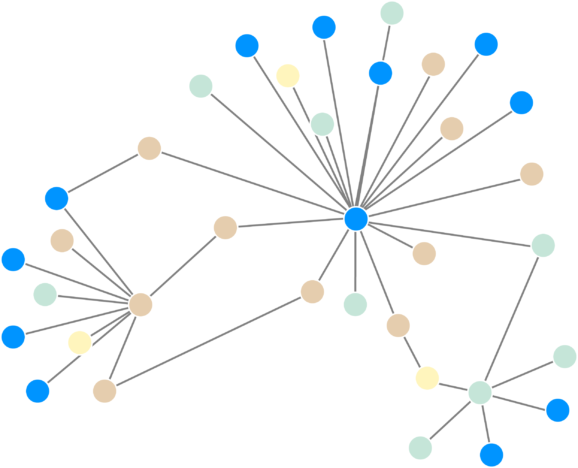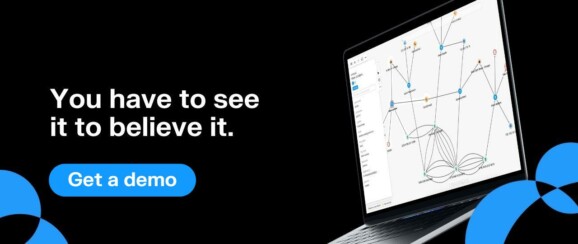Why chief data officers shouldn’t miss out on graph analytics to unlock complex connected data
All kinds of organizations depend on data for business-critical operations. It plays an instrumental role in everything from managing production lines and supply chains to defining growth strategies to preventing fraud, etc.
The role of chief data officer (CDO) is relatively new, but it’s becoming more prevalent across organizations. Today, some 21% of companies have a chief data officer (1), reflecting the growing importance (and volumes) of data within companies. If you’re working as a CDO or in a similar role, you know that high expectations from management combined with these increasing volumes of data can make for seriously challenging work.
One tool that can make the lives of CDOs easier is graph analytics, or network analytics. According to predictions by Gartner, graph technology will be used in 80% of data and analytics projects by 2025. We’ll take a quick look at what graph analytics is, and explore how this type of technology can address some of the main challenges and concerns of today’s chief data officers.
Chief data officers are the executive owners of data within their organization. Some of their main tasks include managing a company’s data resources to address complex business challenges and building a data-driven culture within their organization. According to a recent survey 65% of large, data-driven companies have now appointed a CDO, an increase from 12% in 2012 (2).
The role of CDO is not without its challenges. Some of these are rooted in the fact that many CDOs today are only the first or second person in that role, with much of the scope of their work to be defined. The role also often carries demanding expectations from management.
Many of a CDO’s challenges are closely related to the data itself, however. They may walk into a job and be confronted with existing legacy systems that are costly and time-consuming to change. Data in many organizations is spread across multiple silos. When important data is stored in multiple databases, which may be separated by region or by department, it’s impossible to get a 360° view. And without that complete view, the value a CDO can derive from the data is limited.
Breaking down data silos is critical for organizations to get a complete picture, but the process isn’t always straightforward. It's part of the reason that many CDOs struggle to bring value. According to Gartner, only 44% of data and analytics leaders reported that their team is effective in providing value to their organization (3).
Graph databases can help address all these data challenges.
Let’s take a second to remind ourselves of the basics. A graph data model consists of nodes and edges. Each node represents an entity and each edge represents how two nodes are linked to each other. For example, person A might own bank account B. Nodes and edges also have properties: additional information associated with them. All this information is stored in a graph database.
When you’re working with large datasets or multiple data sources, the relationships within the data can be highly complex. By analyzing data as a graph, it’s possible to determine the closeness of different entities, as well as how entities are connected. Graph analytics provides algorithms that help data-driven analysts answer questions or make predictions using graph data.
By comparison, traditional analytics are more focused on individual data points, either considered separately or aggregated. It can be time-consuming and computationally demanding to analyze relationships within data using traditional methods.

Graph technology not only addresses many of the challenges that today’s chief data officers face. It also helps derive more insights from your data, more quickly. And, bringing in new technology is just a best practice: "Top-performing CDAOs invest in their success by developing skills to thrive in ambiguous circumstances, articulate compelling value stories and identify D&A products and services that can drive business impact," says Alan Duncan, distinguished VP analyst at Gartner (4).
Here are some of the advantages of graph technology for CDOs.
Finding simple connections within relational data is generally fast. But when your work involves analyzing and exploring networks to understand complex connections or dependencies, querying relational data comes at a high computational cost and becomes much slower. On the other hand, since both data points and the connections between them are stored in the same database, querying graph data is blazing fast.
Graph technology helps eliminate data silos, since you can combine multiple data sources into a graph database. Instead of hopping from one data source to another, hoping you don’t miss important insights, you can explore and analyze everything in one place.
Unlike relational databases that have rigid data models, graph databases have a high level of flexibility in how data is stored. This means it’s easier to adapt graph data as your organization’s needs evolve. It’s also easy to add more data from additional sources as needed, making it an easier solution to scale. This is an important consideration at a time when organizations are dealing with huge volumes of data.
Being able to spot patterns and outliers in your data is essential for many businesses. It can alert you to fraud, a security breach, or a potential supply chain disruption. Graph technology is built to easily find patterns and anomalies, so in using graph, you can anticipate problems and react quickly when issues do arise.
A picture is worth a thousand words, and that goes for data, too. Visualizing data as a graph can help you better understand the patterns and insights within, since the human brain processes visual information much more quickly than written text. It’s also easy to share a graph visualization to communicate key information to teammates or stakeholders.
Each graph project will look different depending on factors including your business needs, the type of data you have and the number of datasources, the project objectives, etc. Once your objectives are defined and your data is modeled as a graph, you can import your data to a graph visualization and exploration tool like Linkurious Enterprise to easily access the insights within your data.
Get a demo today to see for yourself how Linkurious Enterprise provides both technical and non-technical users with a deep understanding of relationships and context to drive better decision-making.
(1) https://www.techtarget.com/searchdatamanagement/tip/10-trends-shaping-the-chief-data-officer-role
(2) https://c6abb8db-514c-4f5b-b5a1-fc710f1e464e.filesusr.com/ugd/e5361a_d59b4629443945a0b0661d494abb5233.pdf
(3) (4) https://futurecio.tech/data-and-analytics-not-as-effective-in-delivering-value/
A spotlight on graph technology directly in your inbox.
